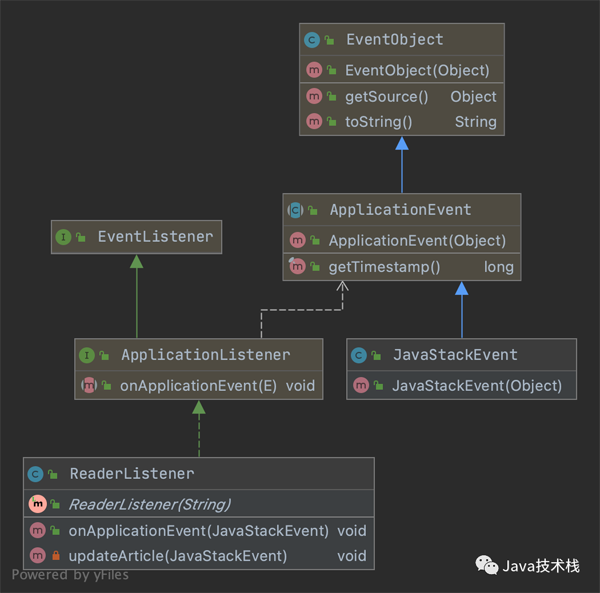жӮЁеҘҪпјҢзҷ»еҪ•еҗҺжүҚиғҪдёӢи®ўеҚ•е“ҰпјҒ
иҝҷзҜҮж–Үз« дё»иҰҒд»Ӣз»ҚвҖңSpringдәӢ件зӣ‘еҗ¬жңәеҲ¶дё»иҰҒж¶үеҸҠеҲ°зҡ„ж ёеҝғзұ»е’ҢжҺҘеҸЈжңүе“ӘдәӣвҖқпјҢеңЁж—Ҙеёёж“ҚдҪңдёӯпјҢзӣёдҝЎеҫҲеӨҡдәәеңЁSpringдәӢ件зӣ‘еҗ¬жңәеҲ¶дё»иҰҒж¶үеҸҠеҲ°зҡ„ж ёеҝғзұ»е’ҢжҺҘеҸЈжңүе“Әдәӣй—®йўҳдёҠеӯҳеңЁз–‘жғ‘пјҢе°Ҹзј–жҹҘйҳ…дәҶеҗ„ејҸиө„ж–ҷпјҢж•ҙзҗҶеҮәз®ҖеҚ•еҘҪз”Ёзҡ„ж“ҚдҪңж–№жі•пјҢеёҢжңӣеҜ№еӨ§е®¶и§Јзӯ”вҖқSpringдәӢ件зӣ‘еҗ¬жңәеҲ¶дё»иҰҒж¶үеҸҠеҲ°зҡ„ж ёеҝғзұ»е’ҢжҺҘеҸЈжңүе“ӘдәӣвҖқзҡ„з–‘жғ‘жңүжүҖеё®еҠ©пјҒжҺҘдёӢжқҘпјҢиҜ·и·ҹзқҖе°Ҹзј–дёҖиө·жқҘеӯҰд№ еҗ§пјҒ
е…¶е®һеңЁ Spring/ Spring Boot жЎҶжһ¶дёӯжңүдёҖеҘ—дәӢ件зӣ‘еҗ¬жңәеҲ¶пјҢеҸҜд»Ҙе®һзҺ°и§ӮеҜҹиҖ…жЁЎејҸгҖӮ
Spring/ Spring Boot жЎҶжһ¶дёӯд№ҹйғҪеҶ…зҪ®дәҶи®ёеӨҡдәӢ件пјҢжҲ‘们д№ҹеҸҜд»ҘиҮӘе®ҡд№үеҸ‘еёғеә”з”ЁзЁӢеәҸдәӢ件пјҢдёӢйқўжҲ‘们дјҡд»Ӣз»ҚгҖӮ
е…¶дё»иҰҒж¶үеҸҠеҲ°зҡ„еҮ дёӘж ёеҝғзұ»е’ҢжҺҘеҸЈеҰӮдёӢ пјҡ
ApplicationEventпјҲеә”з”ЁзЁӢеәҸдәӢ件пјүе®ғжҳҜдёҖдёӘжҠҪиұЎзұ»пјҢзӣёеҪ“дәҺи§ӮеҜҹиҖ…жЁЎејҸдёӯзҡ„и§ӮеҜҹзӣ®ж ҮгҖӮ
ApplicationEvent жәҗз ҒеҰӮдёӢпјҡ
public abstract class ApplicationEvent extends EventObject { /** use serialVersionUID from Spring 1.2 for interoperability. */ private static final long serialVersionUID = 7099057708183571937L; /** System time when the event happened. */ private final long timestamp; /** * Create a new {@code ApplicationEvent}. * @param source the object on which the event initially occurred or with * which the event is associated (never {@code null}) */ public ApplicationEvent(Object source) { super(source); this.timestamp = System.currentTimeMillis(); } /** * Return the system time in milliseconds when the event occurred. */ public final long getTimestamp() { return this.timestamp; } }ApplicationEvent 继жүҝиҮӘ Java дёӯзҡ„ EventObject дәӢ件еҜ№иұЎзұ»пјҢSpring жЎҶжһ¶дёӯзҡ„жүҖжңүдәӢ件йғҪ继жүҝиҮӘ ApplicationEvent зұ»пјҢе®ғжҳҜжүҖжңүдәӢ件зҡ„зҲ¶зұ»гҖӮ
ApplicationEvent дё»иҰҒзҡ„ж ёеҝғжҳҜзұ»жһ„йҖ еҷЁпјҢе®ғеҸҜд»ҘеҲқе§ӢеҢ–дёҖдёӘ source дәӢ件关иҒ”еҜ№иұЎпјҢд»ҘдҫҝеңЁдәӢ件зӣ‘еҗ¬еҷЁдёӯиҺ·еҸ–并йҖҡзҹҘжӣҙж–°гҖӮ
ApplicationListenerпјҲеә”з”ЁзЁӢеәҸдәӢ件зӣ‘еҗ¬еҷЁпјүе®ғжҳҜдёҖдёӘжҺҘеҸЈпјҢзӣёеҪ“дәҺи§ӮеҜҹиҖ…жЁЎејҸдёӯзҡ„и§ӮеҜҹиҖ…гҖӮ
ApplicationListener жәҗз ҒеҰӮдёӢпјҡ
public interface ApplicationListener<E extends ApplicationEvent> extends EventListener { /** * Handle an application event. * @param event the event to respond to */ void onApplicationEvent(E event); }ApplicationListener 继жүҝиҮӘ Java дёӯзҡ„ EventListener дәӢ件зӣ‘еҗ¬жҺҘеҸЈпјҢApplicationListener зұ»дёӯеҸӘжңүдёҖдёӘ onApplicationEvent ж–№жі•пјҢеҪ“жҢҮе®ҡзӣ‘еҗ¬зҡ„дәӢ件被еҸ‘еёғеҗҺе°ұдјҡиў«и§ҰеҸ‘жү§иЎҢпјҢеҸҜд»ҘйҖҡиҝҮ event иҺ·еҸ–дәӢ件дёӯзҡ„е…іиҒ”еҜ№иұЎгҖӮ
еә”з”ЁзЁӢеәҸдәӢ件еҸ‘еёғжҺҘеҸЈпјҢе°ҒиЈ…дәҶдәӢ件еҸ‘еёғеҠҹиғҪзҡ„еҹәзЎҖжҺҘеҸЈгҖӮ
public interface ApplicationEventPublisher { /** * Notify all <strong>matching</strong> listeners registered with this * application of an application event. Events may be framework events * (such as ContextRefreshedEvent) or application-specific events. * <p>Such an event publication step is effectively a hand-off to the * multicaster and does not imply synchronous/asynchronous execution * or even immediate execution at all. Event listeners are encouraged * to be as efficient as possible, individually using asynchronous * execution for longer-running and potentially blocking operations. * @param event the event to publish * @see #publishEvent(Object) * @see org.springframework.context.event.ContextRefreshedEvent * @see org.springframework.context.event.ContextClosedEvent */ default void publishEvent(ApplicationEvent event) { publishEvent((Object) event); } /** * Notify all <strong>matching</strong> listeners registered with this * application of an event. * <p>If the specified {@code event} is not an {@link ApplicationEvent}, * it is wrapped in a {@link PayloadApplicationEvent}. * <p>Such an event publication step is effectively a hand-off to the * multicaster and does not imply synchronous/asynchronous execution * or even immediate execution at all. Event listeners are encouraged * to be as efficient as possible, individually using asynchronous * execution for longer-running and potentially blocking operations. * @param event the event to publish * @since 4.2 * @see #publishEvent(ApplicationEvent) * @see PayloadApplicationEvent */ void publishEvent(Object event); }ApplicationEventPublisher жңүдёҖдёӘй»ҳи®ӨжҺҘеҸЈж–№жі•е’ҢжҺҘеҸЈж–№жі•пјҢжҺҘеҸЈж–№жі•йңҖиҰҒз”ұе…·дҪ“зҡ„еӯҗзұ»е®№еҷЁе®һзҺ°гҖӮ
ApplicationContext иҝҷдёӘзұ»е°ұеҶҚзҶҹжӮүдёҚиҝҮдәҶпјҢе®ғжҳҜ Spring жЎҶжһ¶дёӯзҡ„ж ёеҝғе®№еҷЁгҖӮ
еҰӮдёӢеӣҫжүҖзӨәпјҢApplicationContext жҺҘеҸЈз»§жүҝдәҶ ApplicationEventPublisher жҺҘеҸЈпјҢжүҖд»Ҙеёёз”Ёзҡ„ ApplicationContext е°ұеҸҜд»Ҙз”ЁжқҘеҸ‘еёғдәӢ件гҖӮ

д»ҘдёҠд»Ӣз»Қзҡ„ Spring дәӢ件зӣ‘еҗ¬еҸ‘еёғи§’иүІдёІиө·жқҘе°ұжҳҜпјҢйҖҡиҝҮ ApplicationEventPublisher жҲ–иҖ… ApplicationContext е®№еҷЁеҸ‘еёғ ApplicationEvent дәӢ件并关иҒ”дәӢ件еҜ№иұЎпјҢ然еҗҺ ApplicationListener зӣ‘еҗ¬иҜҘдәӢ件пјҢеҪ“дәӢ件еҸ‘еёғеҗҺпјҢзӣ‘еҗ¬еҷЁе°ұдјҡ收жү§иЎҢ并иҺ·еҸ–еҲ°дәӢ件еҸҠе…іиҒ”еҜ№иұЎгҖӮ
жҗһжҮӮдәҶ Spring жЎҶжһ¶дёӯзҡ„дәӢ件е’Ңзӣ‘еҗ¬жңәеҲ¶пјҢйӮЈжҲ‘们иҝҳжҳҜд»ҘдёҠзҜҮдёӯи§ӮеҜҹиҖ…жЁЎејҸзҡ„дҫӢеӯҗжқҘж”№йҖ дёӢгҖӮ
Spring Boot еҹәзЎҖжҖ§зҡ„зҹҘиҜҶе’Ңжҗӯе»әиҝҮзЁӢе°ұдёҚд»Ӣз»ҚдәҶпјҢдёҚзҶҹжӮүзҡ„еҸҜд»Ҙе…іжіЁе…¬дј—еҸ·JavaжҠҖжңҜж ҲпјҢеңЁеҗҺеҸ°еӣһеӨҚе…ій”®еӯ— "boot" йҳ…иҜ»жҲ‘д№ӢеүҚеҶҷзҡ„зі»еҲ—ж•ҷзЁӢгҖӮ
жүҖжңү Spring Boot ж•ҷзЁӢе®һжҲҳжәҗз ҒеңЁдёӢйқўдёӘд»“еә“пјҡ
https://github.com/javastacks/spring-boot-best-practice
import lombok.Getter; import org.springframework.context.ApplicationEvent; /** * и§ӮеҜҹзӣ®ж Үпјҡж Ҳй•ҝ * жқҘжәҗеҫ®дҝЎе…¬дј—еҸ·пјҡJavaжҠҖжңҜж Ҳ */ @Getter public class JavaStackEvent extends ApplicationEvent { /** * Create a new {@code ApplicationEvent}. * * @param source the object on which the event initially occurred or with * which the event is associated (never {@code null}) */ public JavaStackEvent(Object source) { super(source); } }е®һзҺ° Spring жЎҶжһ¶дёӯзҡ„ ApplicationEvent еә”з”ЁзЁӢеәҸдәӢ件жҺҘеҸЈпјҢзӣёеҪ“дәҺжҳҜдёҖдёӘи§ӮеҜҹиҖ…зӣ®ж ҮгҖӮ
import lombok.NonNull; import lombok.RequiredArgsConstructor; import org.springframework.context.ApplicationListener; import org.springframework.scheduling.annotation.Async; /** * и§ӮеҜҹиҖ…пјҡиҜ»иҖ…зІүдёқ * жқҘжәҗеҫ®дҝЎе…¬дј—еҸ·пјҡJavaжҠҖжңҜж Ҳ */ @RequiredArgsConstructor public class ReaderListener implements ApplicationListener<JavaStackEvent> { @NonNull private String name; private String article; @Async @Override public void onApplicationEvent(JavaStackEvent event) { // жӣҙж–°ж–Үз« updateArticle(event); } private void updateArticle(JavaStackEvent event) { this.article = (String) event.getSource(); System.out.printf("жҲ‘жҳҜиҜ»иҖ…пјҡ%sпјҢж–Үз« е·Іжӣҙж–°дёәпјҡ%s\n", this.name, this.article); } }е®һзҺ° Spring жЎҶжһ¶дёӯзҡ„ ApplicationListener еә”з”Ёзӣ‘еҗ¬жҺҘеҸЈпјҢзӣёеҪ“дәҺжҳҜи§ӮеҜҹиҖ…гҖӮ

import lombok.extern.slf4j.Slf4j; import org.springframework.boot.CommandLineRunner; import org.springframework.context.ApplicationContext; import org.springframework.context.annotation.Bean; import org.springframework.context.annotation.Configuration; @Slf4j @Configuration public class ObserverConfiguration { @Bean public CommandLineRunner commandLineRunner(ApplicationContext context) { return (args) -> { log.info("еҸ‘еёғдәӢ件пјҡд»Җд№ҲжҳҜи§ӮеҜҹиҖ…жЁЎејҸпјҹ"); context.publishEvent(new JavaStackEvent("д»Җд№ҲжҳҜи§ӮеҜҹиҖ…жЁЎејҸпјҹ")); }; } @Bean public ReaderListener readerListener1(){ return new ReaderListener("е°ҸжҳҺ"); } @Bean public ReaderListener readerListener2(){ return new ReaderListener("е°Ҹеј "); } @Bean public ReaderListener readerListener3(){ return new ReaderListener("е°ҸзҲұ"); } }еңЁ Spring й…ҚзҪ®дёӯеҲӣе»әдәҶдёүдёӘиҜ»иҖ… BeanпјҢеңЁ Spring Boot еҗҜеҠЁеҗҺеҸ‘еёғдёҖдёӘи§ӮеҜҹиҖ…жЁЎејҸдәӢ件пјҢ然еҗҺиҝҷдёүдёӘ Bean е°ұдјҡ收еҲ°йҖҡзҹҘгҖӮ
иҫ“еҮәз»“жһңпјҡ

иҝҷйҮҢжҜҸдёӘиҜ»иҖ…еҲӣе»әдёҖдёӘ Bean еҸҜиғҪдёҚеӨӘеҗҲйҖӮпјҢеӣ дёәиҰҒжЁЎд»ҝдёҠдёҖдёӘи§ӮеҜҹиҖ…жЁЎејҸзҡ„еә”з”ЁгҖӮ
е®һйҷ…дёӯзҡ„и§ӮеҜҹиҖ…жЁЎејҸеә”з”Ёеә”иҜҘжҳҜжҢҮе…·дҪ“дёҡеҠЎпјҢдёҫдҫӢиҜҙдёҖдёӘз”өе•Ҷж”Ҝд»ҳеңәжҷҜпјҢеңЁз”ЁжҲ·ж”Ҝд»ҳе®ҢеҗҺеҸҜд»ҘеҸ‘еёғдёҖдёӘж”Ҝд»ҳдәӢ件пјҢ然еҗҺдјҡжңүжүЈеҮҸз§ҜеҲҶпјҢзҹӯдҝЎйҖҡзҹҘгҖҒиө йҖҒдјҳжғ еҲёзӯүдёҖзі»еҲ—еҗҺз»ӯзҡ„дәӢ件зӣ‘еҗ¬еҷЁи§ӮеҜҹиҖ…пјҢиҝҷж ·еҸҜд»Ҙе®һзҺ°дёҡеҠЎи§ЈиҖҰпјҢиҝҷжҳҜдёҖз§ҚеҫҲе…ёеһӢзҡ„еә”з”ЁеңәжҷҜгҖӮ
еҲ°жӯӨпјҢе…ідәҺвҖңSpringдәӢ件зӣ‘еҗ¬жңәеҲ¶дё»иҰҒж¶үеҸҠеҲ°зҡ„ж ёеҝғзұ»е’ҢжҺҘеҸЈжңүе“ӘдәӣвҖқзҡ„еӯҰд№ е°ұз»“жқҹдәҶпјҢеёҢжңӣиғҪеӨҹи§ЈеҶіеӨ§е®¶зҡ„з–‘жғ‘гҖӮзҗҶи®әдёҺе®һи·өзҡ„жҗӯй…ҚиғҪжӣҙеҘҪзҡ„её®еҠ©еӨ§е®¶еӯҰд№ пјҢеҝ«еҺ»иҜ•иҜ•еҗ§пјҒиӢҘжғіз»§з»ӯеӯҰд№ жӣҙеӨҡзӣёе…ізҹҘиҜҶпјҢиҜ·з»§з»ӯе…іжіЁдәҝйҖҹдә‘зҪ‘з«ҷпјҢе°Ҹзј–дјҡ继з»ӯеҠӘеҠӣдёәеӨ§е®¶еёҰжқҘжӣҙеӨҡе®һз”Ёзҡ„ж–Үз« пјҒ
е…ҚиҙЈеЈ°жҳҺпјҡжң¬з«ҷеҸ‘еёғзҡ„еҶ…е®№пјҲеӣҫзүҮгҖҒи§Ҷйў‘е’Ңж–Үеӯ—пјүд»ҘеҺҹеҲӣгҖҒиҪ¬иҪҪе’ҢеҲҶдә«дёәдё»пјҢж–Үз« и§ӮзӮ№дёҚд»ЈиЎЁжң¬зҪ‘з«ҷз«ӢеңәпјҢеҰӮжһңж¶үеҸҠдҫөжқғиҜ·иҒ”зі»з«ҷй•ҝйӮ®з®ұпјҡis@yisu.comиҝӣиЎҢдёҫжҠҘпјҢ并жҸҗдҫӣзӣёе…іиҜҒжҚ®пјҢдёҖз»ҸжҹҘе®һпјҢе°Ҷз«ӢеҲ»еҲ йҷӨж¶үе«ҢдҫөжқғеҶ…е®№гҖӮ
жӮЁеҘҪпјҢзҷ»еҪ•еҗҺжүҚиғҪдёӢи®ўеҚ•е“ҰпјҒ